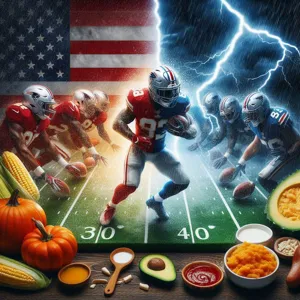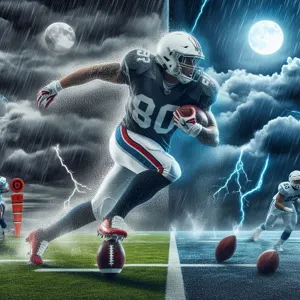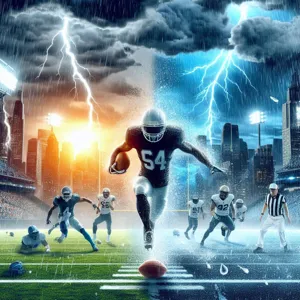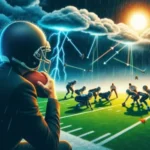As the roar of the crowd fills the stadium and the players take their positions on the field, one factor often looms as a silent but powerful influence: the weather.
Game day in American football is not just about the athletes’ skills and strategies; it’s also about the unpredictable elements of nature that can dramatically shape performance on the field. From the biting chill of a winter wind to the sweltering heat of an early fall afternoon, weather conditions can affect everything from player stamina and ball trajectory to game tactics and fan engagement. In this blog post, we’ll explore the intricate relationship between weather and football, examining how elements like temperature, precipitation, and wind can dictate the outcome of a game and influence coaching decisions. Join us as we delve into the science behind these game day elements and uncover the ways players and teams adapt to Mother Nature’s whims, making each match a thrilling spectacle of skill and resilience.
1. Introduction to Weather’s Impact on Football

In the realm of American football, where strategy and skill converge on the gridiron, the influence of weather conditions cannot be underestimated. From the sweltering heat of late summer to the biting cold of winter, the elements play a pivotal role in shaping the dynamics of the game. As players don their helmets and pads, they must not only contend with their opponents but also with the unpredictable whims of Mother Nature.
Rain-soaked fields can transform the speed of the game, turning crisp passes into slippery struggles and shifting the advantage from agile wide receivers to powerful running backs. Wind can disrupt even the most precise kicks, while snow can blanket the field in a layer of uncertainty, forcing teams to adapt their strategies on the fly. Each weather scenario creates its own set of challenges and opportunities, influencing everything from play-calling to player performance.
Furthermore, the psychological aspect of battling the elements adds another layer of complexity to the game. Teams that thrive in adverse conditions often develop a fierce resilience, using the weather as a rallying point to galvanize their efforts. Conversely, teams unprepared for the elements may find themselves at a disadvantage, struggling to maintain their composure when the skies open up or the temperatures drop.
As we delve deeper into the interplay between weather and football performance, we’ll explore how different conditions can alter tactics, impact player health, and, ultimately, shape the outcome of games. Understanding these elements not only enhances our appreciation for the sport but also highlights the adaptability and tenacity required for success on the field.
2. The Role of Temperature in Player Performance
Temperature plays a pivotal role in shaping the dynamics of American football performance, influencing everything from player endurance to strategic decision-making on the field. As the thermometer creeps up or down, it can dramatically affect how players react and perform under pressure.
In sweltering heat, the physical demands on athletes intensify. Muscles fatigue more quickly, and the risk of dehydration escalates. Players, especially those in positions requiring explosive speed and agility, may find themselves struggling to maintain optimal performance levels as their bodies battle against the oppressive heat. Coaches often adapt strategies to account for this, incorporating more frequent substitutions and hydration breaks to keep their teams at peak performance.
Conversely, when temperatures dip, the game takes on a different character. Cold weather can lead to stiffer muscles and joints, impacting players’ mobility and reaction times. Ball handling becomes more precarious, as both the football and players’ hands become less pliable, resulting in a higher likelihood of fumbles and dropped passes. Quarterbacks may need to adjust their grips and throwing mechanics to accommodate the feel of a colder ball, while receivers must quickly recalibrate their catches.
Beyond the physical implications, temperature also creates a psychological battleground. Players accustomed to warmer climates may struggle mentally when faced with frigid conditions, while those who thrive in cooler temperatures often use the chill to their advantage, embracing the toughness that comes with playing in less-than-ideal conditions. The mental resilience showcased in extreme temperatures can often be the deciding factor in closely contested games.
Ultimately, understanding the effects of temperature on player performance is crucial for coaches and teams. By adapting training regimens and game strategies to align with the weather, teams can enhance their chances of success, ensuring that they not only survive the elements but thrive in them on game day.
3. How Rain Affects Grip and Ball Control

Rainy weather can transform a vibrant game day into a slippery challenge, fundamentally altering the dynamics of American football. When the heavens open up, the field becomes a canvas for unpredictability, where every pass, catch, and tackle is influenced by the conditions underfoot and the moisture in the air.
As raindrops begin to fall, players face immediate challenges regarding grip and ball control. A wet ball is notoriously difficult to handle; its surface becomes slick, making it a formidable foe for quarterbacks and receivers alike. Quarterbacks may find their usual precision compromised as a well-timed spiral turns into a wobbly toss, while receivers struggle to maintain their grip despite their best efforts. This delicate interplay of moisture and grip can lead to a series of dropped passes and fumbled exchanges, significantly affecting the flow and outcome of the game.
Moreover, the condition of the field itself cannot be overstated. A muddy, rain-soaked surface can hinder foot traction, causing players to slip and lose their footing at crucial moments. Running backs may find it challenging to plant their feet effectively for sharp cuts, while defensive players might struggle to maintain their balance during tackles. The result is a game that requires adaptability; teams that can adjust their strategies to accommodate the slippery conditions often find themselves with the upper hand.
To combat the effects of rain, players may resort to specialized gloves with enhanced grip, and quarterbacks might switch to a more textured ball designed for wet weather. Coaches often emphasize the importance of ball security, urging players to keep the ball close and to use two hands when necessary. Ultimately, rain brings an extra layer of excitement and unpredictability to American football, making each game a unique spectacle defined not just by the players, but by the elements that challenge them.
4. Wind Conditions: The Silent Game Changer
When it comes to the intricacies of American football, wind conditions often play a silent yet significant role in shaping the game’s outcome. Unlike rain or snow, which are readily visible and can lead to immediate adjustments in strategy, wind is often underestimated, quietly influencing every play from the snap to the final whistle.
For quarterbacks, a brisk breeze can become an adversary, affecting the trajectory and accuracy of throws. A strong gust can easily transform a well-aimed pass into a wild shot, altering its course mid-flight and sometimes leading to unexpected interceptions. Receivers, too, must adapt; they might find themselves compensating for the wind’s unpredictable shifts, adjusting their routes on the fly to anticipate the ball’s path.
Kicking game strategies are perhaps the most dramatically impacted by wind conditions. A kicker facing heavy gusts must not only consider the distance but also the direction, weighing their approach and technique carefully. A field goal attempt that seems routine in calm weather can become a daunting challenge when the wind howls. Coaches often find themselves recalibrating their decisions, opting for shorter fourth-down attempts or even trick plays to counteract the wind’s effects.
Defensive strategies can shift as well. A fierce wind might encourage teams to ground their offense, pushing them to rely more on the run game to avoid the unpredictability of aerial attacks. On the other hand, a team with a strong wind at their back may take advantage of deep passes, hoping to capitalize on the conditions.
Ultimately, understanding wind conditions gives teams the edge they need to adapt and thrive in challenging environments. Coaches and players who embrace this often-overlooked element can turn what seems like a minor inconvenience into a tactical advantage, making it a vital consideration in the preparation for game day. As fans watch from the stands, they may not realize that the seemingly invisible gusts swirling around the stadium could be the very factor that determines which team walks away victorious.
5. Snow and Ice: Navigating the Elements

As the chill of winter settles in, snow and ice can transform a football field into a battleground of both skill and resilience. These weather conditions introduce a unique set of challenges that can significantly impact player performance, strategy, and overall game dynamics. The sight of flurries dancing through the air and the crunch of frost underfoot can create a picturesque setting, but for players and coaches, the reality is far less romantic.
When snow blankets the field, visibility can become compromised, affecting players’ ability to track the ball and read the movements of their opponents. The whiteout conditions not only challenge the quarterback’s ability to pinpoint a receiver but also test the defensive players’ spatial awareness. In such environments, communication becomes paramount; players must rely heavily on verbal cues and hand signals to navigate the obscured landscape.
Ice poses yet another hurdle, turning turf into a slick surface that can lead to missteps and falls. Footing is precarious, making precise cuts and explosive movements nearly impossible. This often results in a more conservative play style, as players must account for their traction—or lack thereof. Coaches might adjust their game plans to emphasize running plays, where the ball is advanced in shorter, more deliberate bursts, allowing players to maintain control over their movements.
Moreover, the physical toll of playing in freezing temperatures cannot be overlooked. Muscles are more prone to strains and injuries when cold, necessitating a thorough warm-up and continuous movement to keep players limber. Hydration also becomes crucial; players might not feel as thirsty in the cold, but maintaining fluid levels is essential for peak performance.
For fans, snow and ice can create an exhilarating atmosphere, with the thrill of witnessing athletes battle against the elements adding an extra layer of excitement to the game. However, for players, adapting to these frigid conditions requires not just physical prowess but also mental toughness. Embracing the challenge of snow and ice can be the difference between a memorable victory and a hard-fought defeat, making every touchdown and tackle a testament to the resilience and adaptability of the athletes on the field.
6. Humidity’s Effect on Endurance and Hydration
Humidity plays a crucial role in the dynamics of American football, impacting players’ endurance and hydration levels in profound ways. When the air is saturated with moisture, as it often is during the sweltering summer months or in regions with a humid climate, the body’s natural cooling mechanism becomes less effective. Under these conditions, sweat evaporates more slowly, forcing players to rely on perspiration to regulate their body temperature. As a result, athletes can overheat more quickly, leading to a decline in performance, increased fatigue, and a higher risk of heat-related illnesses.
Endurance becomes a major concern when humidity levels rise. Players may find themselves gasping for breath as their bodies expend more energy to cope with the oppressive heat. This heightened demand for stamina means that even the most conditioned athletes can struggle to maintain their peak performance throughout a game. As they tire, their reaction times slow, decision-making becomes impaired, and the risk of injury escalates.
Moreover, hydration takes on paramount importance in humid conditions. Players must be diligent about their fluid intake, as the combination of heat and humidity can lead to rapid dehydration, which diminishes both physical and cognitive functions. Coaches and trainers emphasize the need for athletes to hydrate before, during, and after games, urging them to replenish not just water but also electrolytes lost through sweat. Failure to maintain proper hydration can lead to muscle cramps, dizziness, and even heat exhaustion, severely affecting a team’s ability to compete effectively.
As teams prepare for games in humid conditions, strategizing not only around playbooks but also around hydration protocols and endurance training becomes essential. Understanding how humidity impacts performance enables coaches and players to adapt their tactics, ensuring that they remain competitive no matter the weather. In essence, managing humidity’s effect on endurance and hydration is not just a matter of comfort—it’s a critical factor in maximizing performance on the field.
7. The Psychology of Playing in Adverse Conditions

The psychology of playing in adverse conditions can significantly impact a team’s performance on game day. When athletes step onto the field, they are not only battling their opponents but are also contending with the elements. Inclement weather—whether it’s pouring rain, biting cold, or sweltering heat—can introduce a unique mental challenge that tests the resolve and adaptability of players and coaches alike.
Adverse conditions can evoke a range of psychological responses. For some athletes, the presence of rain or snow can create a sense of dread or anxiety, leading to hesitation and mistakes. The slippery turf and reduced visibility can amplify these feelings, making even the simplest maneuvers feel daunting. On the other hand, some players thrive in challenging weather, using it as an opportunity to showcase their grit and determination. These athletes often view adverse conditions as a test of their mental toughness, fostering a competitive spirit that can inspire the entire team.
Coaches play a crucial role in shaping their players’ mindsets in these situations. A positive, adaptable approach can help mitigate fear and encourage players to embrace the challenge. Teams that engage in thorough preparation—practicing in similar conditions before the game—tend to perform better when faced with unexpected weather. This preparation not only builds physical resilience but also instills confidence, allowing players to focus on technique rather than the elements.
Moreover, the psychological impact of weather extends beyond individual players. Team dynamics can shift dramatically in adverse conditions. A shared struggle can bond teammates closer together, fostering camaraderie and collective resilience. Conversely, adverse conditions can also lead to frustration and blame if things don’t go as planned, highlighting the need for strong leadership and communication.
In essence, understanding the psychology of playing in adverse conditions is essential for teams aiming to maximize their performance. By addressing both the mental and physical aspects of weather-related challenges, teams can gain a strategic edge, transforming a potentially detrimental situation into an opportunity for triumph.
8. Historical Game Day Weather Highlights
When it comes to American football, the weather has played a pivotal role in shaping the game’s most memorable moments and outcomes. Historical game day weather highlights reveal a fascinating interplay between environmental conditions and player performance, often determining the fate of teams in pivotal matchups.
Take, for instance, the infamous “Ice Bowl” of 1967, where the Green Bay Packers faced off against the Dallas Cowboys in temperatures that plummeted to -15 degrees Fahrenheit, with wind chills making it feel even colder. The frigid conditions turned Lambeau Field into a frozen battleground. Players struggled to grip the ball, and their breath turned to clouds of steam as they fought through the bone-chilling cold. Yet, it was the Packers who triumphed in that legendary contest, demonstrating how grit and determination can sometimes prevail against the harshest of weather conditions.
Then there’s the “Fog Bowl” of 1988, where the Chicago Bears clashed with the Philadelphia Eagles. A thick fog rolled into Soldier Field, reducing visibility to a mere few yards. Players and fans alike were engulfed in a surreal atmosphere, where the sounds of the game echoed in the mist. Despite the challenges, the Bears emerged victorious, showcasing their resilience in an environment that tested the limits of both strategy and physical ability.
More recently, the Super Bowl XLVIII in 2014 at MetLife Stadium brought its own set of weather-related challenges. The New England Patriots and Seattle Seahawks battled it out under overcast skies and a brisk chill. Though the weather was relatively mild for February, it was the swirling winds that played a crucial role, impacting passes and forcing teams to adjust their game plans on the fly. The Seahawks adapted better to these conditions, leading them to their first Super Bowl victory, emphasizing how crucial it is to prepare for the unpredictable elements of game day.
These historical weather highlights underscore that American football is not just a battle of skill and strategy; it’s also a dance with nature. Understanding how weather affects performance can provide teams with a competitive edge, allowing them to adapt their tactics and optimize their chances of success, regardless of what Mother Nature has in store on game day.
9. Strategies Teams Use to Adapt to Weather
When it comes to American football, the weather can dramatically influence the outcome of a game. Teams that excel in adapting their strategies to varying weather conditions often gain a competitive edge over their opponents. Here’s how they do it.
**Challenging the Elements: Preparation is Key**
Before the whistle blows, teams conduct meticulous preparations tailored to the forecast. Coaches analyze weather patterns weeks in advance, adjusting their training regimens accordingly. For instance, if rain is expected, teams may focus on ball-handling drills to ensure players can securely grip the ball in slippery conditions. Similarly, in anticipation of hot weather, hydration protocols and conditioning sessions are ramped up to help athletes acclimate and maintain peak performance.
**Game Plan Adjustments: Offense and Defense**
Once the game day arrives, teams often shift their play-calling strategies based on the conditions. In windy environments, for instance, coaches may opt for a more ground-based attack, relying on running plays that minimize the risk of errant passes. In contrast, in ideal weather conditions, offenses might unleash aerial assaults, taking advantage of the ability to throw accurate passes without interference from Mother Nature. Defensively, teams will adjust their coverage schemes to counteract the opposing team’s weather-based tactics, ensuring they remain a step ahead.
**Equipment Tweaks: The Right Gear Matters**
Players also adapt their gear to combat weather challenges. During cold games, you might see athletes wearing specialized undergarments designed to retain heat and wick moisture away from the body. In wet conditions, teams might choose gloves with enhanced grip or cleats designed to provide better traction on slippery turf. Additionally, the choice of footballs can be critical; teams may prefer balls with a surface that provides superior grip when wet, enabling them to maintain control even under adverse conditions.
**Mental Resilience: Embracing the Challenge**
Beyond physical adaptations, mental resilience plays a crucial role in how teams cope with weather-related challenges. Coaches often emphasize a positive mindset, encouraging players to embrace the elements rather than shy away from them. By fostering a culture of adaptability and toughness, teams can better handle the unexpected twists that weather can bring during a game.
In essence, the ability to adapt to weather conditions is an intricate dance of preparation, strategy, equipment adjustments, and mental fortitude. Teams that master these elements not only enhance their performance but also build a reputation for resilience, making them formidable contenders on any game day.
10. Equipment Choices Based on Weather Conditions
When it comes to American football, the right equipment can be the difference between a triumphant game and a disheartening loss, especially when weather conditions come into play. Players and coaches must carefully consider their gear based on the elements they will face on game day.
In rainy or wet conditions, for instance, the choice of cleats becomes paramount. Players often opt for longer, molded studs that offer better traction on slippery fields, minimizing the risk of slips and falls. Additionally, gloves with enhanced grip technology are crucial in preventing fumbles, as wet conditions can transform even the most secure catch into a potential turnover.
Cold weather introduces another set of challenges. Players may choose to wear thermal base layers, which provide crucial insulation while still allowing for the freedom of movement necessary for optimal performance. Equipment managers often ensure that players have access to hand warmers and heated benches on the sidelines, as maintaining body temperature is vital for both comfort and functionality during the game.
On the flip side, hot and humid conditions require players to focus on hydration and ventilation. Lightweight, moisture-wicking fabrics are a must, allowing sweat to evaporate quickly and keeping athletes cool. Coaches might also implement strategies on the sidelines to rotate players more frequently, ensuring that everyone stays fresh and hydrated throughout the game.
Ultimately, the choices made regarding equipment can greatly influence a team’s performance under various weather conditions. By taking the time to select the right gear tailored to the day’s forecast, players can not only enhance their individual performance but also contribute to their team’s success on the field. Whether it’s the grip of their cleats or the breathability of their jerseys, these decisions can make all the difference when the stakes are high and the elements are at play.
11. Case Studies: Memorable Games and Their Weather Impact
Weather has the uncanny ability to transform a regular game into a legendary spectacle, often dictating the outcome in ways that players and coaches must painstakingly navigate. Let’s delve into a few memorable cases where weather conditions played a pivotal role in shaping the narrative of American football.
One of the most iconic examples is the infamous “Tuck Rule Game” during the 2002 AFC Divisional Playoff between the Oakland Raiders and New England Patriots. On that fateful night in Foxborough, the game was marred by a heavy snowfall, creating a surreal winter wonderland that made visibility and footing precarious. As the snowflakes cascaded down, players struggled to maintain their grip on the field, leading to a series of fumbles and slips. The Patriots, however, adapted quickly, leveraging their home-field advantage and the inclement weather. Quarterback Tom Brady’s resilience shone through as he orchestrated a remarkable comeback, cementing his legacy and the Tuck Rule’s place in NFL history.
Another noteworthy example is the 1981 NFC Championship Game, held at the famed Candlestick Park in San Francisco. Known for its notorious winds, this game featured the San Francisco 49ers facing off against the Dallas Cowboys. The weather conditions were not just a mere backdrop; they became a central character in the unfolding drama. The howling winds dramatically affected kicking games, forcing teams to rethink their strategies on field goals and punts. The 49ers ultimately triumphed, but it was the swirling gusts that often dictated their plays, showcasing how weather can redefine game plans and player performances.
In more recent history, the “Ice Bowl” of 1967 between the Green Bay Packers and the Dallas Cowboys is forever etched in the annals of football lore. Played in sub-zero temperatures, with wind chills plummeting to -36 degrees Fahrenheit, this game tested the physical and mental fortitude of all involved. Players were bundled in layers, but nothing could fully prepare them for the bone-chilling cold. As players battled not just their opponents but the elements, every tackle, every snap, and every yard gained was a testament to their sheer willpower. The Packers emerged victorious, but it was the brutal conditions that turned this championship clash into a legendary story of endurance and grit.
These case studies illustrate how weather conditions can profoundly influence game dynamics, strategy, and player performance. As teams gear up for their next battle on the gridiron, the potential impact of the elements looms large, a reminder that in American football, the forecast can be just as crucial as the final score.
12. The Role of Coaching in Weather Preparedness
When it comes to American football, weather conditions can dramatically influence the dynamics of the game, and coaching plays a pivotal role in preparing players to adapt and thrive in varying climates. Coaches are not just strategists; they are also the architects of resilience, instilling in their teams the ability to respond to the unpredictable nature of outdoor play.
A savvy coach understands that each weather element—from scorching heat to biting cold, from torrential rain to gusty winds—requires specific strategies and preparations. For instance, during a hot summer game, a coach might implement hydration protocols, emphasizing the importance of staying hydrated before, during, and after the game. They might also modify practice schedules to avoid the peak sun hours, ensuring players are physically conditioned to handle the heat when game day arrives.
Conversely, in colder conditions, a coach will prioritize warm-up routines that focus on keeping muscles limber and reducing the risk of injury, understanding that frigid temperatures can lead to stiffness and decreased performance. Layering techniques for uniforms, coupled with strategic timeouts to regroup and ensure players are mentally sharp, become essential components of their game plan.
Moreover, a coach’s ability to read the weather and adapt game strategies accordingly can mean the difference between victory and defeat. In rainy conditions, for example, a team may rely more heavily on the run game, reducing the risk of fumbles and taking advantage of the slippery turf to outmaneuver opponents. Coaches will also emphasize ball security and precise route running, ensuring players are prepared for the challenges posed by wet conditions.
Ultimately, the role of coaching in weather preparedness extends beyond just physical readiness; it encompasses the psychological aspect as well. A coach who instills confidence in their players, reassuring them that they can overcome adverse conditions, fosters a resilient mindset that can elevate performance, regardless of the weather. In this way, effective coaching becomes a critical element in navigating the unpredictable nature of game day, empowering teams to embrace the elements and rise to the occasion.
13. Fan Experience: How Weather Influences Attendance and Atmosphere
Weather conditions play a pivotal role in shaping the fan experience at American football games, influencing not just attendance but also the overall atmosphere of the event. Imagine a crisp autumn afternoon, where the air is cool and the leaves are just beginning to show their vibrant colors. Fans don their team colors, wrapped in cozy blankets, and gather in the stands, the excitement palpable. In contrast, picture a sweltering summer day, temperatures soaring, where fans might think twice before heading to the stadium. The heat can diminish enthusiasm, leading to sparser crowds and a quieter ambiance.
Rain, snow, or extreme winds can further complicate the situation. A drizzle might encourage fans to don their favorite rain jackets and brave the elements, but heavy downpours can deter even the most devoted supporters, resulting in empty seats and a lackluster atmosphere. On a snowy day, while the sight of flurries falling on the field can create a picturesque scene, it can also mean slippery conditions that may keep casual fans at home, opting for the comfort of their warm living rooms over the frosty bleachers.
Moreover, the weather directly impacts the game itself, influencing how fans react to plays and the general mood in the stadium. A sunny day can energize the crowd, amplifying cheers and creating an electric environment. Conversely, harsh weather can lead to frustration, with fans more focused on staying warm or dry than fully engaging with the game.
Organizations are increasingly aware of the influence of weather on attendance and atmosphere, often incorporating weather forecasts into their planning. Pre-game festivities may be adjusted, additional heating or cooling measures implemented, and contingency plans put in place to ensure that the fan experience can remain as enjoyable as possible, regardless of the elements.
Ultimately, understanding how weather shapes attendance and atmosphere is crucial for teams and organizers. By considering these factors, they can enhance the overall game day experience, drawing in fans and creating an unforgettable environment that keeps them coming back, no matter the forecast.
14. Future Trends: Technology and Weather Forecasting in Football
As we look to the future, the intersection of technology and weather forecasting is poised to revolutionize how teams prepare for and perform in American football. Innovations in meteorological technology are enabling coaches and athletes to access hyper-localized weather data that can influence game strategies and player conditioning on a granular level.
Imagine a scenario where real-time weather updates are seamlessly integrated into play-calling decisions. Coaches could adjust their game plans on the fly, taking into account factors such as wind speed, humidity, and temperature fluctuations that occur during the game. Advanced analytics software is already beginning to incorporate weather predictions into player performance models, allowing teams to tailor their training regimens based on anticipated conditions for upcoming games.
Moreover, wearable technology is playing a crucial role in this evolution. Smart devices equipped with sensors can monitor players’ physiological responses to various weather conditions, providing valuable insights that can shape training schedules and recovery protocols. For instance, if a player is known to struggle in high heat, data collected from their performance in similar conditions can inform hydration strategies and cooldown routines to ensure optimal performance.
In addition, the rise of augmented reality (AR) and virtual reality (VR) training environments offers teams the ability to simulate various weather scenarios, allowing players to practice and adapt to potential game-day conditions without the unpredictability of Mother Nature. This proactive approach not only enhances player readiness but also boosts confidence, as athletes become accustomed to executing plays in adverse weather.
As these technological advancements continue to develop, the future of football will likely see a deeper integration of weather forecasting with player performance analytics, revolutionizing preparation and strategy at all levels of the game. With the ability to anticipate and react to the whims of weather more effectively than ever before, teams will find themselves better equipped to turn challenges into opportunities, making every game day a showcase of not just skill, but also of strategic innovation.
15. Conclusion: Embracing the Elements for Game Day Success
In the world of American football, the elements are not just background noise; they are critical players on the field that can shape the outcome of a game. As we’ve explored throughout this post, weather conditions—be it the blistering heat of summer, the biting chill of winter, or the unpredictable whims of rain and wind—can significantly influence team performance, strategies, and ultimately, the game’s result.
Understanding and embracing these elements can provide teams with a competitive edge. Coaches and players who adapt their strategies to accommodate weather conditions can turn potential disadvantages into advantages. For instance, a team that practices under adverse conditions can build resilience and resourcefulness, essential traits for success on game day.
Moreover, preparation is key. Teams that invest time in understanding the meteorological nuances of their home field and traveling venues can optimize their practice schedules, conditioning programs, and game plans. From selecting the right cleats to tailoring play styles to counteract the wind or rain, these small adjustments can lead to significant gains when it matters most.
As fans, we also play a role in the game day experience. Dressing appropriately for the weather and bringing the right gear can enhance our enjoyment of the game, regardless of the elements. By embracing the weather—whether it’s a sunny afternoon or a snowy night—we become part of the rich tapestry of the sport, cheering on our teams through thick and thin.
In conclusion, rather than shying away from inclement weather, teams, players, and fans alike should embrace it. The elements are an integral part of American football, adding layers of complexity and excitement to each game. By understanding and adapting to these conditions, we can all contribute to a more thrilling and successful game day experience. After all, in the world of football, it’s not just about the game; it’s about mastering the elements that surround it.
In conclusion, understanding how weather conditions impact American football performance can provide teams with a strategic edge on game day. From the biting chill of winter winds to the sweltering heat of summer afternoons, each element can influence players’ stamina, tactics, and overall gameplay. By preparing for these conditions and adapting strategies accordingly, teams can enhance their chances of success on the field. As you gear up for the next big game, consider how the weather might play a role in your favorite team’s performance. Whether you’re a player, coach, or passionate fan, embracing the unpredictability of the elements can lead to thrilling moments and unforgettable victories. So, next time you settle in to watch a game, take a moment to appreciate the intricate dance between the weather and the athletes, and cheer them on as they navigate the challenges of game day!






